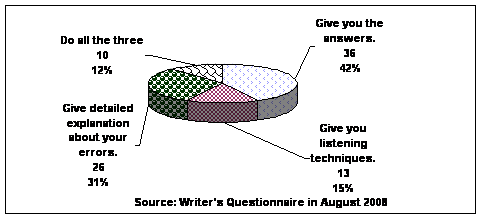SOME STRATEGIES FOR STUDENTS TO AVOID THE TYPICAL TRAPS IN THE LISTENING SECTION OF THE TOEIC TEST
Hoang Vinh Loc *
Abstract
The scores of the Test of English for International Communication (TOEIC) indicate how well people can communicate in English with others in business, commerce and industry. Actually, it is agreed by several authors that in order to achieve satisfactory success in the TOEIC test, one need to improve both his language skills and test-taking skills. This research introduces the typical traps and specific strategies for the listening section of the TOEIC test to help the students be confident in taking the TOEIC test.
Although listening is widely known as a receptive skill, it requires a lot of efforts and practice and involves a great deal of activity on the part of the listener. Vandergrift (1999:1) once highlighted the characteristics of listening comprehension:
It is a complex, active process in which the listener must discriminate between sounds, understand vocabulary and grammatical structures, interpret stress and intonation, retain what was gathered in all of the above, and interpret it within the immediate as well as the larger socio-cultural context of the utterance.
As for that, a competent communicator should be able to successfully process the auditory input in a short time. Listening comprehension items used in the TOEIC test are of authentic spoken English that ESL or EFL learners can hear or use in real-life situations, which also reflects their speaking competence in business communicative environment. However, the writer’s survey shows that about 26% of the participants who are third-year English majors at Lac Hong have difficulty in completing all the listening items of the TOEIC test. The problem is that the participants have to get at least 750 points of the TOEIC test as a condition for their graduation, which also means they must get at least 375 points of both listening comprehension and reading comprehension sections. On the other hand, about 68% of the participants said they were very anxious about being able to get 750 points of the test and 16% of them said they were afraid that they would not be able to get the scores above.
The writer’s hypothesis was that after having acquaintance with the traps and knowing the strategies for avoiding them, the students can succeed in taking the test and getting the required test scores. In this research, the writer wishes to introduce the typical traps in the TOEIC listening section and effective strategies for avoiding them. Besides, the writer, at the position of a language learner would like to make some recommendations for improving the students’ listening skill for the TOEIC test and building more effective listening classes at the Faculty of Foreign Languages of Lac Hong University.
The traps with illustrated examples introduced in the research were believed to be the typical and most problematic ones by the participants of the research and were taken from the following TOEIC preparation books.
1. Building Skills for the TOEIC® Test by Richardson Gina & Michele Peters.
2. Upgrading TOEIC Test-taking Skills – Target TOEIC by Anne Taylor.
3. Longman Preparation Series for the TOEIC Test-Advanced Course by Lin Lougheed.
4. Tactics for TOEIC Listening and Reading Test by Grant Trew.
Hereafter is a short introduction with illustrated examples to three most common traps which are Same-or-similar-sound traps, Questions and responses in authentic spoken English and Word used out of context.
Same or similar sounds: In the answer choices of TOEIC listening section, there are words or phrases that sound the same or very similar to those in the listening texts. The words that sound the same can be homophones - words pronounced like other words but having different spellings or meanings.
Example:
 |
a. Two businesspeople are walking past a park. (correct)
b. The businesspeople are working in the park.
c. The woman is walking alone.
d. The men are walking past a park.
|
Answer choice c. and d. contain the word ‘walking’, which is the same as that in the correct answer, but the subjects in these sentences are not appropriate for the context of the picture.
Answer choice b. contains the word ‘working’ which sounds similar to the word ‘walking’ in the correct answer. Working /wç:kiî/ - Walking /wä:k17/
Answer choice a. contains the phrase ‘airport lounge’ which is the same as in the correct answer choice; however, it is not a good description of the picture.
Answer choice b. and c. contain the word ‘board’ which can make listeners make a wrong assumption about the context of the picture.
Question and Response:
²What’s the exchange rate today?
a. You can exchange it if you have a receipt.
b. The same as yesterday. (correct)
c. Most people resist change.
The question asks about the exchange rate of the day. Answer choice a. tries to confuse listeners by repeating the word ‘exchange’ in the question; however, it belongs to a different context. Answer choice c. contains the phrase ‘resist change’ which sounds similar to the word ‘exchange’.
Questions and responses in authentic spoken English: Part II of the TOEIC listening section includes short questions and responses in daily communication. It is noticeable that in this part of the test, listeners should not expect responses to Yes/No questions to begin with ‘Yes’ or ‘No’ or to answer the questions directly.
Examples:
² Have you finished the minutes of the meeting?
a. I’m almost done.
b. Yes, it took them a month to finish.
c. No, the finish is very smooth.
As we can see from the situation above, answer a. ‘I’m almost done.’ is the most appropriate response to the question; however, it does not begin with ‘Yes’ or ‘No’. Although answer choice b. and c. contain the word ‘finish’ and begin ‘Yes’ or ‘No’, they are not relevant to the context of the question.
Word used out of context: In the answer choices of all four parts of the TOEIC listening section, there are attractive words which can be found in the pictures, questions, statements, conversations or talks, but they are, in fact, irrelevant to the contexts of the listening texts, which can lead listeners to making incorrect inferences.

Answer choice a. contains the words ‘serious accident’ which are used out of context. Although there does have a big pile of sand on the road, in the actual context of the picture this sand pile is not resulted from any severe traffic accident. The sand pile is being used for reconstructing the road.
Answer choice d. also contains words used out of context: ‘car / crushed’. There are several cars on the road, but in the context of the picture these cars are running smoothly; therefore, it is unreasonable to infer from the picture that a car has been crushed or squeezed.
The strategies mentioned below are from the writer’s own experience in taking the TOEIC test and from the aforementioned TOEIC preparation books.
Part I : Picture Description
- Make use of the time for the direction to predict possible nouns/verbs and statements that relates to the context of the pictures before you actually listen to the recordings.
- Listen carefully for the similar-or-same-sound traps. Do not hastily mark an answer choice when you have not listened to all the answer choices provided.
Part II: Questions and Responses
- Do not always expect Yes/No responses to YES/NO questions.
- Pay special attention to question words to determine the right responses. (What / When/ Where /Why / How…)
|
Wh-Words
|
Possible Answer Types
|
Example
|
|
Who
|
Name, title, identification
|
Ms. Engle, the manager, the man in the gray cap, etc.
|
|
What
|
Object, idea, event
|
the computer, the manufacturing process, the theory, the banquet, etc.
|
|
When
|
Time, day, month, year
|
1:00 on Tuesday, in the afternoon, in April, on the fifteenth, in 1996
|
|
Where
|
Place, location
|
In the park, on the table, in a meeting
|
|
Why
|
Reason, explanation
|
Because the copier is broken, so that he will know how to get there
|
|
How
|
Method, means, way
|
Pull this handle, follow these directions, do this first.
|
|
How + adj
|
Length of object or time
|
11 inches, 3 hours
|
|
How + adv
|
Quantity
|
4 pints, enough, some for everybody
|
- Be careful with the similar or same sounds and homophones.
Words that sound similar at the beginning:
Personal – personnel
Magnet – magnate
Than – then
Device – devise
etc.
Words that sound similar at the end:
Hand – brand
Cab – tab
Large – charge
Pay – say
etc.
One-syllable words that have similar vowels
zip – tip – ship
night – write – high – flight
how – now – plow
etc.
Words that sound similar when combined with other words.
They’re – their
He’ll – hill
We’ll – well
etc.
Homophones:
Ad (advertisement): Did you see this ad in the paper?
Add (addition): Did you add these numbers correctly?
Sale (low prices): Mr. Sulka bought his boat on sale.
Sail (travel by boat): Mr. Sulka likes to sail his boat on weekends.
Part III. Short Conversations:
- Pay special attention to answer choices that contain the same words as those in the recordings.
- Learn to identify denial and refusal phrases and listen carefully to the information that follows them.
Example: We used to, but… / No, I’m sure they wouldn’t… / We can, but… / I’m afraid we can only… / I’d love to, but… / I don’t think we’ll be able to…
- Answer the questions as quickly as you can so that you can have a little time to look at the next questions and answer choices.
Part IV. Short Talks:
- Pay attention to the questions that ask about numbers, time, quantity and location and listen carefully to the details that answer the questions.
- Be careful with similar-or-same-sound traps.
- Answer the questions as quickly as you can so that you can have a little time to look at the next questions and answer choices.
In terms of methodology, a combination of qualitative and quantitative approaches was exploited in the research so as to have the most persuasive and reliable data and interpretation.
The instruments used in the research include the questionnaire, tests and interviews. The questionnaire and tests were carried out among 85 third-year English majors from three day-time classes - 06AV2, 06AV3 and 06AV4 - at the Faculty of Foreign Languages of Lac Hong University. The questionnaire includes 7 selected-response items written in English. The pre-test and post-test were intentionally selected from the practice tests of Target TOEIC book by Anne Taylor. The original TOEIC format of the tests was kept the same, but the number of test items in the pre-test and post-test was reduced by half that of the real ones. The interviews were carried out among twenty students who made no or a little progress in the post-test. All together, the above research instruments provide the writer with adequate and consistent source of data.
The research goes through the following steps. 1. Problem identification. 2. Plan of action. 3. Plan implementation. 4. Comparison and reflection
The results from questionnaire, tests and interviews shed light on several attention-grabbing facts about the TOEIC listening classes, students’ expectations and effectiveness of the trap and strategies introduction. Here are the major findings and interpretations:
Facts about listening classes:Looking into the facts about the students’ listening classes may help identify the cause of their anxiety about the TOEIC test. Question 6 in the questionnaire was designed to ask about what the listening teachers are doing with TOEIC listening materials in their classes. Here are the results from the questionnaire:

Figure 01: TOEIC Listening Classes
The chart shows that when teaching TOEIC listening materials, the teachers mainly give the students answers (42%). Only 15% of the teachers give the students listening techniques or strategies for the TOEIC listening section. As a matter of fact, the students should obtain good listening skills and strategies to avoid the traps intentionally designed by the test-makers.
Student’s expectations from the teachers:The following table shows the participants’ answers to the question: ‘What would you expect from your teachers to help you with your listening skill for the TOEIC test?’
| |
Answers
|
Samples
|
Percentage
|
|
Show you the ‘traps’ right at the beginning of your listening course.
|
80
|
85
|
94.12%
|
|
Design TOEIC listening tests to evaluate your levels at the end of each academic year.
|
75
|
85
|
88.24%
|
|
Provide you with different sources of listening.
|
63
|
85
|
74.12%
|
|
Help you identify the purposes of listening tasks.
|
56
|
85
|
65.88%
|
|
Total
|
274
|
85
|
|
Figure 02: Student’s Expectations from the Teachers
It is obvious from the table above that most of the students (94.12%) need to be introduced to the traps in the TOEIC listening right at beginning of their course. In addition, 88.24% of the students agreed that they should know their listening levels at the end of each academic year.
The results of the listening tests:To check the effectiveness of the strategies for avoiding the traps, the writer designed a pre-test and a post-test – described in the Research methodology and procedure. The data were carefully analyzed and summarized in the following table.
|
|
06AV2
|
06AV3
|
06AV4
|
|
∑ Set Traps (traps)
|
1020
|
1020
|
850
|
|
∑ Traps Pre-test (traps)
|
418
|
408
|
387
|
|
∑ Traps Post-test (traps)
|
273
|
288
|
296
|
|
∑ Trap Reduction (at least 3 traps) (samples)
|
26
|
23
|
19
|
|
∑ Trap Reduction (samples)
|
68
|
|
% Trap Reduction (/85 samples)
|
80%
|
Figure 03: Results of the listening tests
The table shows that 80% of the students to whom the traps and strategies had been introduced made progress within only two weeks. This result indicates that after knowing the traps and practicing using the strategies to avoid them, most of the students can avoid a number of traps in the listening section of the TOEIC test, which also helps confirm the writer’s hypothesis about the effectiveness of the traps and strategies introduction.
However, the other 20% of the students could not recognize the traps when they did the post-test. To find out the root of the problem, the writer decided to interview these students. Surprisingly, all of them had problems with the speed the recordings, limited vocabulary, and short–term concentration. These problems considered by Underwood (1989) are related to the learners’ different language backgrounds. Also, all of the interviewees believed that their performance on test 2 would have been much better if they had been given more time to study the traps and practice the strategies on their own.

Students’s disscussion at an English Speaking Club
Through the research, the writer would like to make some recommendations to the students to help the students improve their listening skills for the TOEIC test. Firstly, it is advisable for the learners to approach every source of the target language. They can surround themselves with English from different channels on television, from various websites on the Internet, from English songs and even from their classmates.
Secondly, the learners should accept the fact of listening to authentic materials without understanding every word. Students should not be discouraged if they cannot catch up with every single word. Instead, they should only focus on listening to the information that answers the questions. Davies and Pearse (2000:76) said it was not unusual for native speakers with no problems with hearing or environmental distracters to miss some words spoken to them.
As a final point, ‘Practice makes perfect.’ as the saying goes. Regular practice to TOEIC listening materials can significantly help the learners get used to the test format, adjust themselves to the speed of the recordings and enhance their concentration on the test. The more they practice the more self-confident they become.
In addition, the writer would like to make some recommendations to teachers at the Faculty of Foreign Languages to build more effective TOEIC listening classes.
To begin with, the introduction of the traps and strategies for TOEIC listening can go together with general listening lessons in the listening classes. It is not necessary for the teachers to simply focus on the traps and the strategies, but a combination of general listening materials and TOEIC preparatory materials can be exploited.
Additionally, communicative activities can be used to teach TOEIC listening classes. Forster and Karn (1998:46) suggested that TOEIC Listening Comprehension section could provide a variety of opportunities for communicative activities which might actually help the students achieve higher test scores because they will be more familiar with and confident about the test if they have actually used the language from the test.
Last but not least, the Faculty of Foreign Languages can collaborate with TOEIC Lac Hong Center to support the teachers in designing TOEIC listening tests to evaluate their student’s levels at the end of each academic year. These tests will help the students know their levels so that they can set up their goals for the next academic year and reduce their anxiety about the TOEIC test.
Due to the limit of time and knowledge, this research merely focuses on the listening section of the TOEIC test. Therefore, further studies might look into the following undone aspects of the research such as traps and strategies for the Reading section of the TOEIC test and other problems and factors that affect the students’ performance on the TOEIC test.
In conclusion, the writer finds out that it is their lack of practice to the TOEIC listening, knowledge about the traps and strategies and essential listening skills that makes the students anxious about the TOEIC test. Above all, by testing the students’ performances on the listening tests, the writer manages to prove that knowing the traps and strategies can help the students avoid the traps in the test and improve their test scores.
REFERENCES
1. Davies, P. & Pearse, E. (2000). Success in English Teaching. Oxford, NY: Oxford University Press.
3. Lougheed, L. (2004) Longman Preparation Series for the TOEIC Test. HCMC: HCMC Publishing House.
4. Richardson, G. & Peters, M. (2005). Building Skills for the TOEIC® Test. HCMC: HCMC Publishing House.
5. Taylor, A. Upgrading TOEIC Test-taking Skills – Target TOEIC. 2nd ed. HCMC: Youth Publishing House.
6. Trew, G. (2007). Tactics for TOEIC Listening and Reading Test. Oxford: Oxford University Press.
7. Underwood, M. (1989). Teaching Listening. London: Longman.
8. Vandergrift, L. (1999). Facilitating second language listening comprehension: acquiring successful strategies. ELT Journal, 53(3), 168-176.
----------------------------------------------------------------------------------------------------------------------------------------------------------------------------------------------------------------------------------------------------
* Hoang Vinh Loc, a student of class 04AV3, graduated from Lac Hong University in 2008. He achieved 950/990 points of the TOEIC test and is currently working at the Faculty of Foreign Languages – Lac Hong University.






